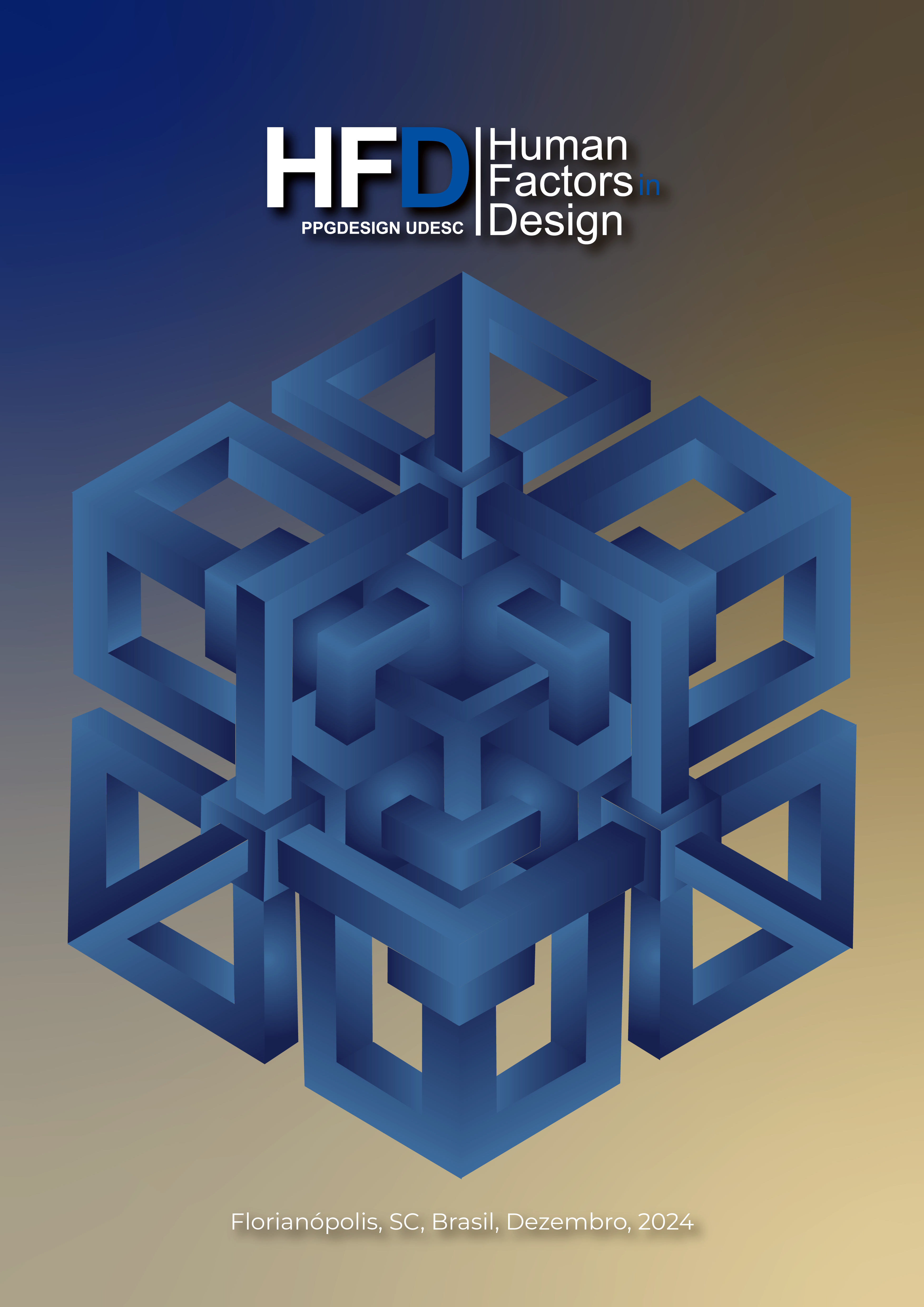Usability and Accessibility in Assistive Technology for Visually Impaired
DOI:
https://doi.org/10.5965/2316796313262024069Keywords:
Assistive Technology, Visual Impairment, Usability, Accessibility, GuidelinesAbstract
This study presents a systematic review focused on identification and analysis of the use of usability and accessibility guidelines in Assistive Technologies (AT) for visually impaired. The research analyzes nine papers and the perspectives of four renowned authors in the field of usability and the development of interactive systems. The study also highlights five insights found in the papers, considered fundamental in the development of AT. The conclusion points to the importance of using these guidelines, as currently, the limited integration of specialized knowledge in this area leads to a restriction in the effective development of applications.
Downloads
References
ASSOCIAÇÃO BRASILEIRA DE NORMAS TÉCNICAS. Norma Brasileira ABNT NBR 9050. Acessibilidade a edificações, mobiliário, espaços e equipamentos urbanos. 4 ed. Rio de Janeiro: ABNT, 2020.
BERSCH, Rita. Introdução à Tecnologia Assistiva. Porto Alegre: CEDI, 2017. 20 p.
BRASIL. Lei nº 13.146 de 6 de julho de 2015. Institui a Lei Brasileira de Inclusão da Pessoa com Deficiência (Estatuto da Pessoa com Deficiência). Disponível em: https://www.planalto.gov.br/ccivil_03/_ato2015-2018/2015/lei/l13146.htm.
CHARLTON, J. I. Nothing about us without us: disability oppression and empowerment. 3 ed. Berkeley, California: Univ. of California Press, 2004.
CHINCHAI, Pisak; INTHANON, Rattanaroj; WANTANAJITTIKUL, Kittichai; CHINCHAI, Supaporn. A white cane modified with ultrasonic detectors for people with visual impairment. Journal of Associated Medical Sciences. [S. l.]: Chiang Mai University. 2022.
CRESWELL, J. W. Projeto de pesquisa: métodos qualitativo, quantitativo e misto. tradução: Luciana de Oliveira da Rocha. 2. ed. Porto Alegre: Artmed, 2007.
DAVIS, Lennard J. Enforcing normalcy: Disability, deafness and the body. London, New York: Verso, 1995.
DINIZ, Debora. O que é deficiência?. São Paulo: Brasiliense, 2006.
ELLIS, Kirsten et al. Bespoke Reflections: Creating a One-Handed Braille Keyboard. Proceedings of the 22nd International ACM SIGACCESS Conference on Computers and Accessibility, ACM 2020, pp. 1-13.
FLOYD, Christiane. A paradigm change in software engineering. ACM SIGSOFT Software Engineering Notes. [S. l.]: Association for Computing Machinery (ACM), 1988.
GADIRAJU, V.; MUEHLBRADT, A.; KANE, S. K. BrailleBlocks: Computational Braille Toys for Collaborative Learning. Proceedings of the 2020 CHI Conference on Human Factors in Computing Systems. Anais Honolulu HI USA: ACM, abr. 2020.
JAGATHEESWARI, M. et al. iBraille - An Arduino based Assistive Technology for the Blind. 2022 6th International Conference on Intelligent Computing and Control Systems (ICICCS). Anais...Madurai, Índia: IEEE, 25 maio 2022.
JANIDARMIAN, Majid et al. Wearable Vibrotactile System as an Assistive Technology Solution. Mobile Networks and Applications. [S. l.]: Springer Science and Business Media LLC, 2019.
LANTER, D.; ESSINGER, R. User‐Centered Design. Em: RICHARDSON, D. et al. (Eds.). International Encyclopedia of Geography. 1. ed. [s.l.] Wiley, 2017. p. 1–4.
MACE, R; STORY, M.F.; MUELLER, J.F. The Universal Design File: designing for people of all ages and abilities. North Carolina: NC University, 1998.
MAEDA, J. The laws of simplicity. Cambridge, Mass: MIT Press, 2006.
MANDUCHI, R.; COUGHLAN, J. (Computer) vision without sight. Communications of the ACM Association for Computing Machinery (ACM). 2012.
MARTILLANO, Dennis A. et al. PINDOTS: An Assistive Six-dot Braille Cell Keying Device on Basic Notation Writing for Visually Impaired Students with IoT Technology. Proceedings of the 2018 2nd International Conference on Education and E-Learning, 2018.
MULLER, M. J.; MCCLARD, A. Validating an extension to participatory heuristic evaluation: quality of work and quality of work life. CHI’95. Em: CONFERENCE COMPANION. US: ACM Press, 1995.
MULLER, M. J. et al. Methods & tools: participatory heuristic evaluation. Interactions, v. 5, n. 5, p. 13–18, set. 1998.
MURAD, Hasan; TRIPTO, Nafis Irtiza; ALI, Mohammad Eunus. Developing a bangla currency recognizer for visually impaired people. Proceedings of the Tenth International Conference on Information and Communication Technologies and Development, 2019.
MUSTAFA, Ali; OMER, Ahmed; MOHAMMED, Ogba. Intelligent Glasses for Visually Impaired People. 2022 14th International Conference on Computational Intelligence and Communication Networks (CICN). [S. l.]: IEEE, 2022.
NIELSEN, J. Enhancing the explanatory power of usability heuristics. Proceedings of CHI’94. Boston: ACM, 152-158. 1994.
NIELSEN, Jakob; MOLICH, Rolf. Heuristic evaluation of user interfaces. In: Proceedings of the SIGCHI Conference on Human Factors in Computing Systems (CHI ''90). New York, NY, USA: ACM, 1990. P. 249-256.
NIELSEN, J. Usability engineering. Boston: Academic Press, 1993.
OMS. Global Report on Assistive Technology. Geneva: Organização Mundial da Saúde (OMS) e United Nations Children’s Fund (UNICEF), 2022. Disponível em: https://www.who.int/publications/i/item/9789240049451. Acesso em: 03 set. 2023.
SMITH, D. W.; KELLY, S. M.; KAPPERMAN G. Assistive technology for students with visual impairments. Position paper of the Division on Visual Impairments, Council for Exceptional Children. Arlington, VA: Council for Exceptional Children, 2011.
SHNEIDERMAN, B.; PLAISANT, C. Designing the user interface: strategies for effective human-computer interaction. 5th ed. Boston: Addison-Wesley, 2010.
ZHU, H. Y. et al. An investigation into the effectiveness of using acoustic touch to assist people who are blind. (I. A. Khan, Ed) PLOS ONEPublic Library of Science (PLoS), out. 2023.
Downloads
Published
How to Cite
Issue
Section
License
Copyright (c) 2024 Human Factors in Design

This work is licensed under a Creative Commons Attribution 4.0 International License.
Os artigos publicados pela revista são de uso gratuito, destinados a aplicações acadêmicas e não comerciais. Os direitos autorais são todos cedidos à revista. Os artigos cujos autores são identificados representam a expressão do ponto de vista de seus autores e não a posição oficial da revista Human Factors Design. O (s) autor (es) se compromete a sempre que publicar material referente ao artigo publicado na Revista Human Factors Design mencionar a referida publicação da seguinte forma:
Este artigo foi públicado originalmente pela Revista Human Factors Design em seu volume (colocar o volume), número (colocar o número) no ano de (colocar o ano) e pode ser acessado em: https://periodicos.udesc.br/index.php/hfd/index


